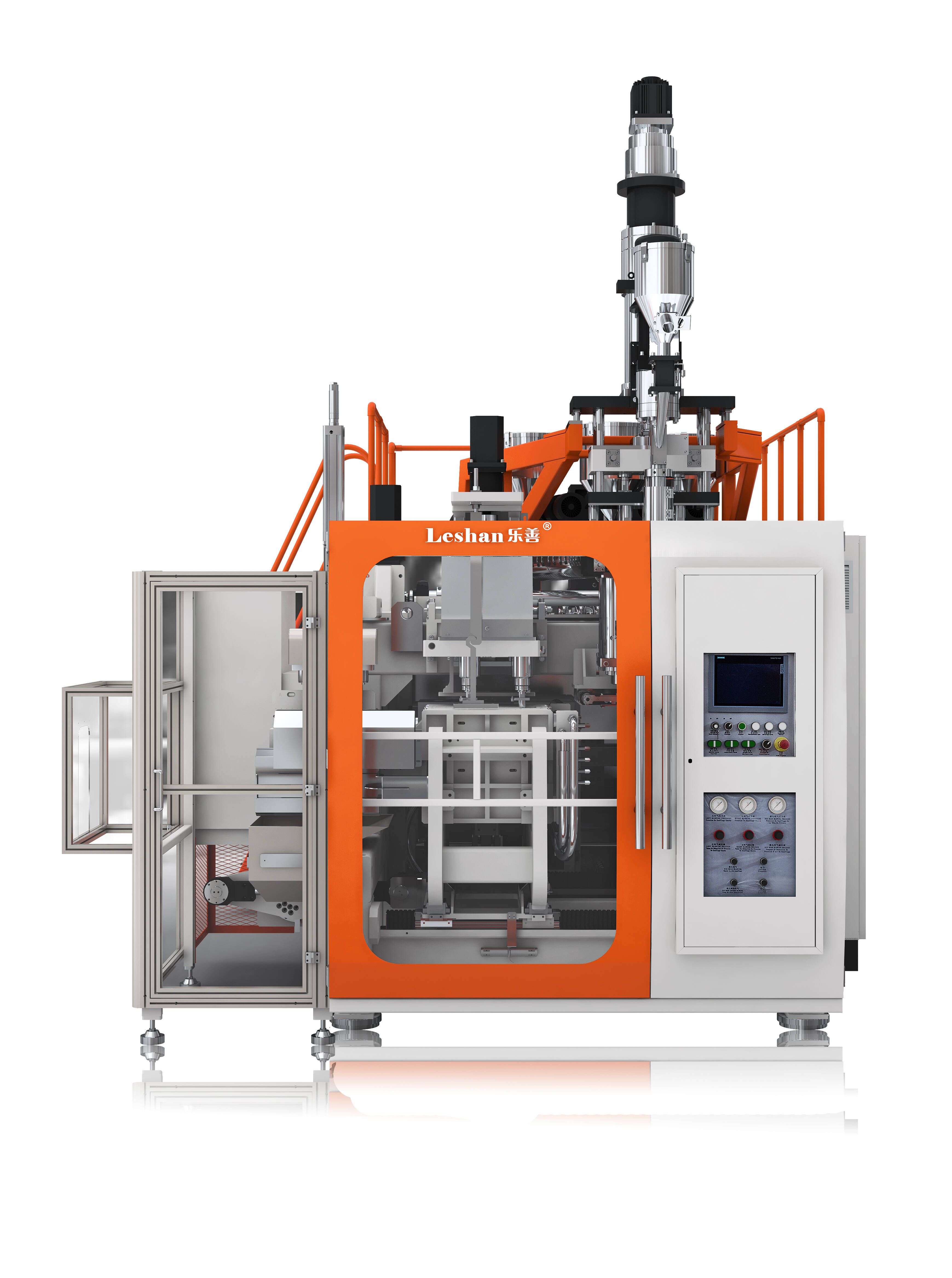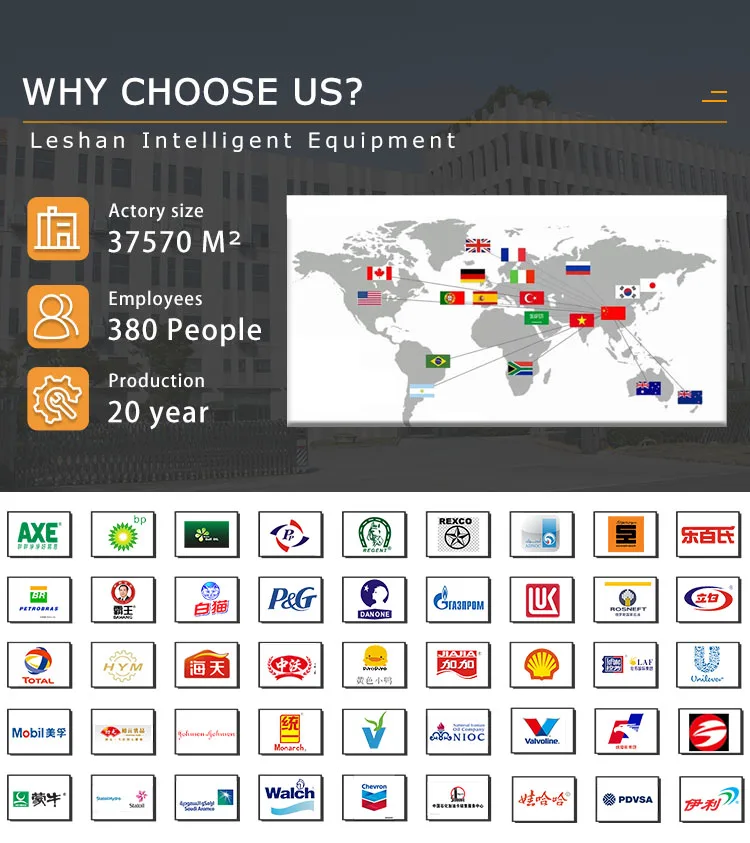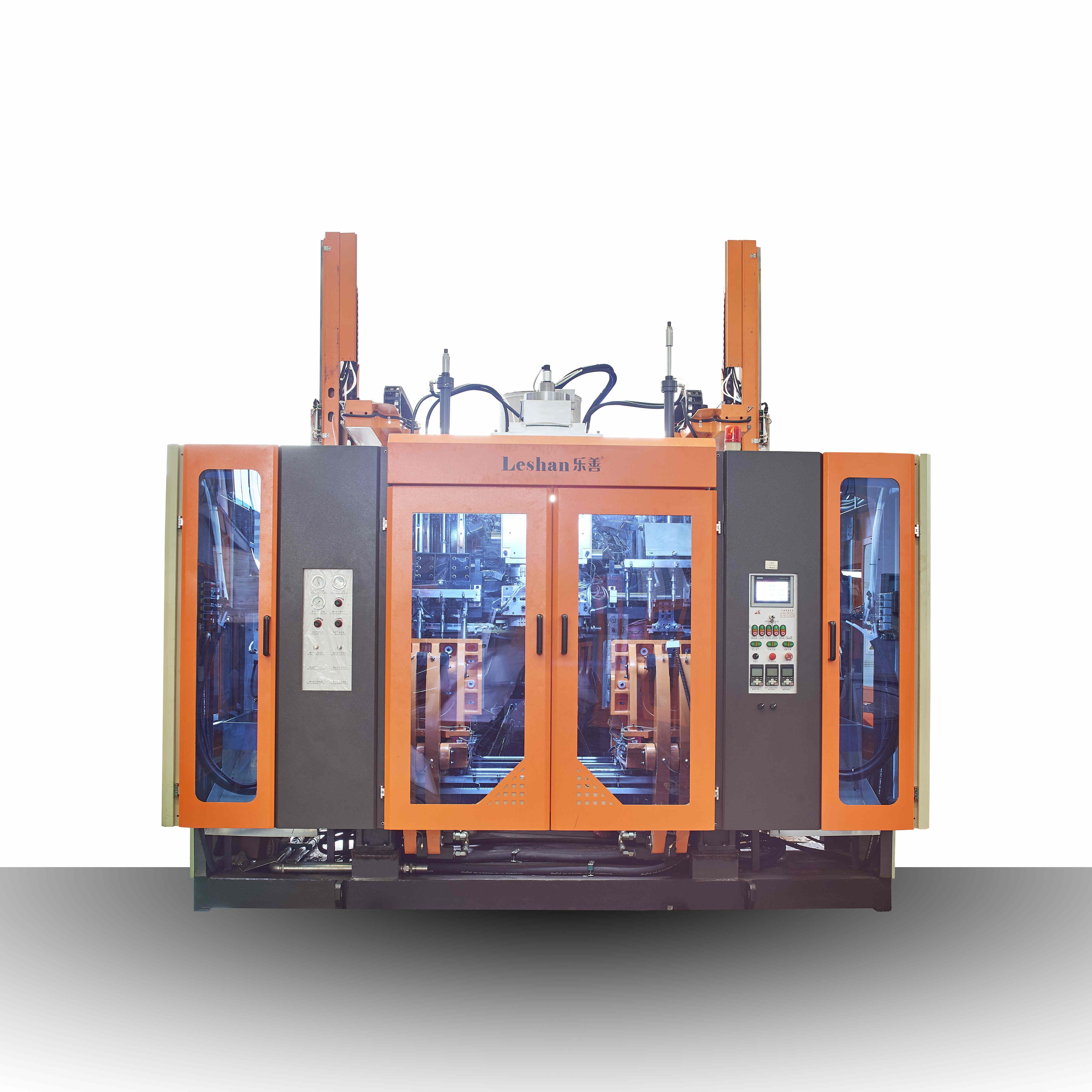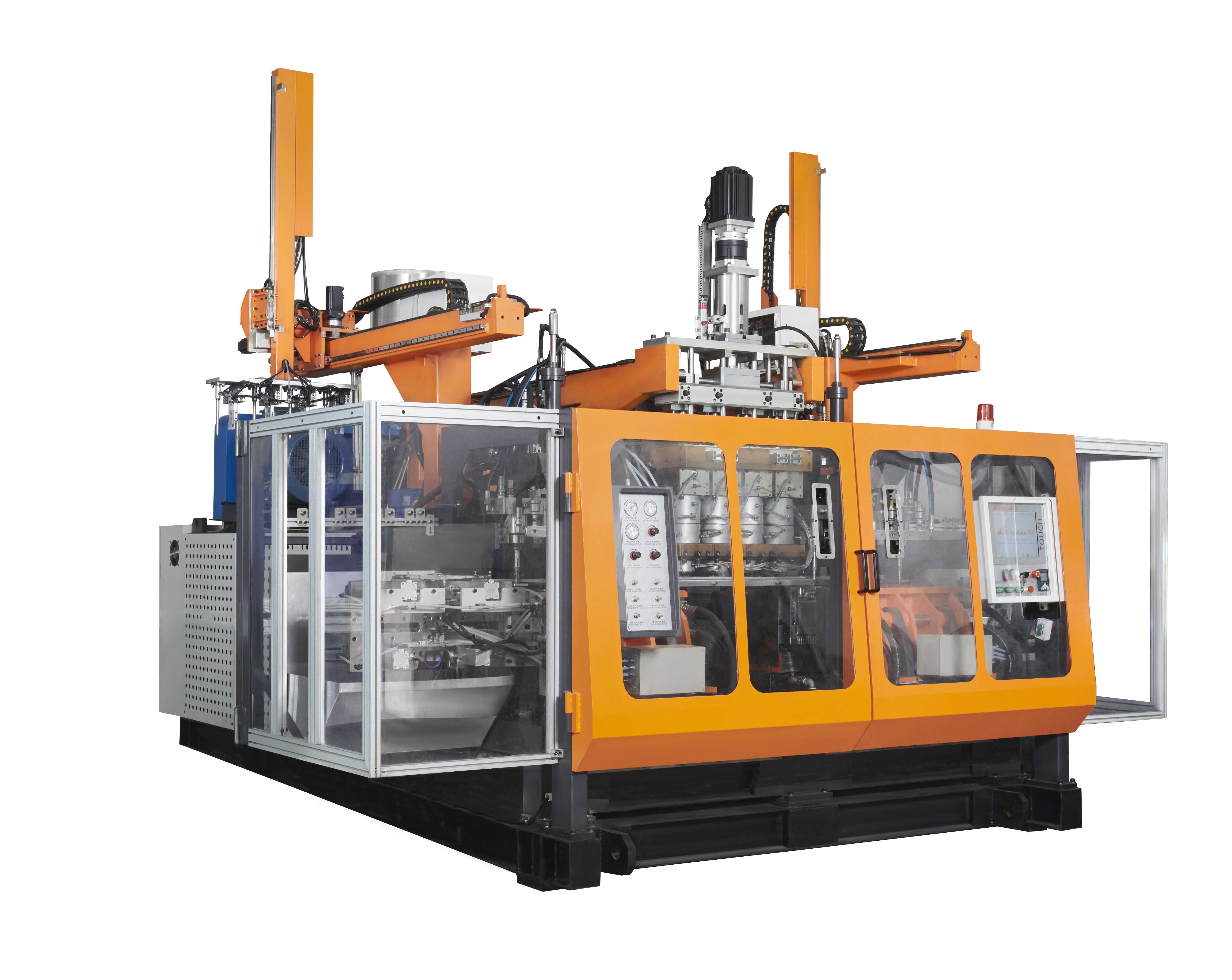
Extrusion blow molded containers
Extrusion blow molded containers
Leshan Machinery Company is a leading domestic manufacturer of blow molding machine. LESHAN provides services to the global plastic industry. After decades of effort and development, we have established a technical team composed of excellent plastic machinery professionals with rich theoretical knowledge and practical experience. They have always spared no effort in the development of blow molding machines.
Our main products include All Electronic PET Blow Molding Machine, High precision Mold, Food bottle blow molding machine,Auxiliary machine,Daily chemistry bottle blow molding machine,Extrusion Die Head,Engine oil bottle blow molding machine,Irregular shape product blow molding machine,Milk bottle blow molding machine,Chemical barrel blow molding machine,multi-layer coextrusion blow molding machine, etc. Our products are sold to over 50 countries worldwide. After purchasing our products, no matter where you are, we will immediately provide after-sales service, technical support, on-site service, and operator training related to the components if needed.
| Parameter | Information |
| Product Name | extrusion blow molded containers |
| Place of Origin | Foshan,Guangdong,China |
| Brand Name | Leshan |
| Condition | New |
| Video outgoing-inspection | Provided |
| Machinery Test Report | Provided |
| Warranty of core components | 1 year |
| Warranty | 1year |
| Port | ShunDe/GuangZhou/ShenZhen China |
| Application | Bottle |
| Core Components | Gearbox,Engine,Motor,Gear,Pump,PLC...etc |
| Color | customized |
| Plastic Processed | PP,PC,PE,EVA,HDPE,ABS...etc |
| Certification | CE,ISO9001:2012... |
| PLC Brand | Siemens |
| Packaging Details | Standard exporting machine packing with plastic film |
| Service | Free spare parts |
| Automation | Automation |
| Supply Ability | 500 Set/Sets per year |
| Lead time (days) | 70 (To be negotiated) |
Please note: The above table data is for reference only. For specific information, please contact us.

extrusion blow molded containers also has the characteristics of high efficiency, energy saving and environmental protection. During the manufacturing process, the blow molding machine can reduce energy consumption and the generation of emissions by recycling waste gas and waste liquid, thereby achieving the purpose of energy saving and emission reduction.
In addition, the blow molding machine can also use multi-layer molds to provide products with composite properties and increase the added value of the product.

extrusion blow molded containers---FAQs Guide
2.How do extrusion blow molded containers manufacturers control variables like temperature, pressure, and blow time in the blow molding process to ensure consistent product quality?
3.What are the common problems in the production process of extrusion blow molded containers?
4.What are the safety standards for extrusion blow molded containers?
5.What are the general raw materials for extrusion blow molded containers?
6.How to solve the vibration problem of blow molding machine?
7.What is the level of automation of extrusion blow molded containers?
8.How to choose a extrusion blow molded containers that suits your own craft?
9.How to design and customize extrusion blow molded containers?
10.What kind of bottle is suitable for making with the Leshan blow molding machine?
11.What are the main components of a extrusion blow molded containers?
1.Is there a limit to the size range of extrusion blow molded containers?
We continue to invest in research and development and continue to launch innovative products.
Yes, there is a limit to the size range of blow molding machines. The size range of blow molding machines is typically determined by the maximum volume of the mold cavity and the maximum clamping force of the machine. The maximum volume of the mold cavity can range from a few milliliters to several liters, while the maximum clamping force can range from a few tons to several hundred tons.
Therefore, the size range of blow molding machines can vary greatly depending on the specific machine and its capabilities. Generally, blow molding machines are used to produce plastic products ranging from small bottles and containers to larger items such as automotive parts and large industrial containers.
2.How do extrusion blow molded containers manufacturers control variables like temperature, pressure, and blow time in the blow molding process to ensure consistent product quality?
We pay attention to the transformation of intellectual property protection and innovation achievements. Your OEM or ODM order design we have a complete confidentiality system.
1. Temperature Control: Blow molding machines have heating elements that are used to heat the plastic material to a specific temperature before it is blown into the mold. The temperature is controlled by sensors and thermostats that monitor and adjust the temperature as needed. This ensures that the plastic material is at the optimal temperature for the blow molding process, which helps to produce consistent product quality.
2. Pressure Control: The pressure in the blow molding process is controlled by the air pressure in the mold. The blow molding machine has a pressure regulator that controls the amount of air that is blown into the mold. This pressure is monitored and adjusted to ensure that it is consistent throughout the molding process. This helps to ensure that the plastic material is evenly distributed and that the final product has consistent wall thickness.
3. Blow Time Control: The blow time refers to the amount of time that the air is blown into the mold to inflate the plastic material. This is a critical variable in the blow molding process as it determines the final shape and size of the product. Blow molding machines have timers that control the duration of the blow time, and these can be adjusted to ensure consistent product quality.
4. Process Monitoring: Blow molding machine manufacturers also use advanced process monitoring systems to track and control the variables in the blow molding process. These systems use sensors and software to monitor and adjust the temperature, pressure, and blow time in real-time. This helps to ensure that any variations in these variables are immediately detected and corrected, resulting in consistent product quality.
5. Quality Control: In addition to controlling the variables during the blow molding process, manufacturers also have quality control measures in place to ensure consistent product quality. This includes regular testing and inspection of the final products to check for any defects or variations. Any issues are identified and addressed to maintain the desired level of product quality.
3.What are the common problems in the production process of extrusion blow molded containers?
As one of the extrusion blow molded containers market leaders, we are known for innovation and reliability.
1. Inconsistent Wall Thickness: This is a common problem in blow molding machines where the thickness of the plastic material is not uniform throughout the product. This can lead to weak spots in the product and affect its overall strength and durability.
2. Flashing: Flashing occurs when excess plastic material leaks out of the mold during the production process. This can result in a rough or uneven surface on the final product, affecting its appearance and functionality.
3. Warping: Warping is a common problem in blow molding machines where the product becomes distorted or deformed during the cooling process. This can be caused by uneven cooling or improper mold design.
4. Air Traps: Air traps occur when air gets trapped inside the mold during the production process. This can result in air bubbles or voids in the final product, affecting its strength and appearance.
5. Poor Surface Finish: Poor surface finish can be caused by a variety of factors, including improper mold design, poor quality plastic material, or inadequate cooling. This can result in a rough or uneven surface on the final product.
6. Leaks: Leaks can occur in blow molding machines due to worn or damaged seals, improper alignment of the mold, or inadequate clamping force. This can result in product defects and production downtime.
7. Contamination: Contamination can occur in the production process when foreign particles or impurities get mixed in with the plastic material. This can result in defects in the final product and affect its quality and functionality.
8. Machine Malfunctions: Like any other machinery, blow molding machines can experience malfunctions such as electrical issues, mechanical failures, or software glitches. These can result in production delays and affect the overall efficiency of the production process.
4.What are the safety standards for extrusion blow molded containers?
We are a new extrusion blow molded containers manufacturer.
1. Electrical Safety: Blow molding machines should comply with all relevant electrical safety standards, such as the National Electrical Code (NEC) and the International Electrotechnical Commission (IEC) standards.
2. Machine Guarding: All moving parts of the machine should be guarded to prevent accidental contact and injuries. The guards should be securely fixed and not easily removable.
3. Emergency Stop: The machine should have an easily accessible emergency stop button that can quickly shut down the machine in case of an emergency.
4. Lockout/Tagout: The machine should have a lockout/tagout system in place to prevent accidental start-up during maintenance or repair.
5. Pressure Relief: Blow molding machines use high-pressure air to mold plastic, so they should have a pressure relief system in place to prevent over-pressurization and potential explosions.
6. Material Handling: The machine should have a safe and efficient material handling system to prevent injuries and accidents during the loading and unloading of materials.
7. Noise Control: Blow molding machines can produce high levels of noise, so they should have noise control measures in place to protect workers' hearing.
8. Fire Safety: The machine should have fire safety measures in place, such as fire extinguishers and fire alarms, to prevent and control fires.
9. Operator Training: All operators should receive proper training on how to operate the machine safely and be aware of potential hazards.
10. Regular Maintenance: The machine should undergo regular maintenance and inspections to ensure it is in good working condition and meets all safety standards.

5.What are the general raw materials for extrusion blow molded containers?
We pay attention to employee development and benefits, and provide a good working environment in order to improve the efficiency of employees and improve the quality management of extrusion blow molded containers products.
1. Plastic Resin: The most common raw material used in blow molding machines is plastic resin, which is melted and formed into a hollow tube to create the desired shape.
2. Colorants: Colorants are added to the plastic resin to give the final product its desired color.
3. Additives: Additives such as UV stabilizers, antioxidants, and flame retardants may be added to the plastic resin to improve the properties of the final product.
4. Compressed Air: Compressed air is used to inflate the plastic tube and shape it against the mold.
5. Mold Release Agents: Mold release agents are used to prevent the plastic from sticking to the mold during the molding process.
6. Lubricants: Lubricants are used to reduce friction between the plastic and the mold, making it easier to remove the final product.
7. Cooling Water: Cooling water is used to cool the plastic and solidify it into the desired shape.
8. Mold Inserts: Mold inserts are used to create specific features or details on the final product.
9. Labels and Packaging Materials: Labels and packaging materials may be added to the final product after it has been molded.
10. Recycled Materials: Some blow molding machines may also use recycled plastic materials as a raw material, reducing waste and promoting sustainability.
6.How to solve the vibration problem of blow molding machine?
Adjust the pressure and flow parameters of carriage PQ valve to make the carriage action more smoothly.
7.What is the level of automation of extrusion blow molded containers?
We have advantages in marketing and channel expansion. Suppliers have established good cooperative relations, continuously improved workflows, improved efficiency and productivity, and provided customers with high -quality products and services.
The level of automation of blow molding machines can vary depending on the specific machine and its capabilities. Some blow molding machines may have basic automation features such as automatic preform loading and bottle ejection, while others may have more advanced automation capabilities such as automatic mold changeovers, robotic handling of bottles, and integrated quality control systems. Overall, the level of automation in blow molding machines has increased in recent years with the development of new technologies and advancements in the industry.
8.How to choose a extrusion blow molded containers that suits your own craft?
We continue to improve extrusion blow molded containers products and processes to improve efficiency.
1. Determine the type of blow molding process: There are three main types of blow molding processes - extrusion blow molding, injection blow molding, and stretch blow molding. Each process has its own advantages and is suitable for different types of products. Determine which process is most suitable for your product before choosing a machine.
2. Consider the size and shape of your product: Blow molding machines come in different sizes and have different capabilities. Consider the size and shape of your product to determine the size and type of machine you need. For example, if you are producing large containers, you will need a machine with a larger clamping force and a larger mold size.
3. Look for a reputable manufacturer: It is important to choose a reputable manufacturer when buying a blow molding machine. Look for manufacturers with a good track record and positive reviews from other customers. This will ensure that you get a high-quality machine that is reliable and durable.
4. Check the machine's features and capabilities: Different blow molding machines come with different features and capabilities. Some machines may have advanced features such as multi-layer co-extrusion, while others may have simpler features. Consider the features that are important for your production process and choose a machine that meets your requirements.
5. Consider the production volume: The production volume of your product will also play a role in choosing the right blow molding machine. If you have a high production volume, you will need a machine with a higher output and faster cycle times. On the other hand, if you have a lower production volume, a smaller machine with a lower output may be more suitable.
6. Look for after-sales support: It is important to choose a manufacturer that offers good after-sales support. This includes technical support, spare parts availability, and maintenance services. A good after-sales support system will ensure that your machine runs smoothly and any issues are resolved quickly.
7. Consider your budget: Blow molding machines can be a significant investment, so it is important to consider your budget when choosing a machine. However, it is also important to keep in mind that a cheaper machine may not always be the best option in terms of quality and performance. Consider the long-term benefits and ROI when making your decision.
8. Test the machine: If possible, visit the manufacturer's facility and test the machine before making a purchase. This will give you a better understanding of the machine's capabilities and help you make an informed decision.
9. Seek expert advice: If you are new to blow molding, it is advisable to seek advice from experts in the industry. They can provide valuable insights and help you choose a machine that is suitable for your specific needs.
10. Consider future growth: It is important to consider your future growth plans when choosing a blow molding machine. Choose a machine that can accommodate your future production needs and can be upgraded if necessary. This will save you from having to invest in a new machine in the future.

9.How to design and customize extrusion blow molded containers?
We actively participate in the extrusion blow molded containers industry associations and organization activities. The corporate social responsibility performed well, and the focus of brand building and promotion
Designing and customizing blow molding machines involves several steps and considerations. Here are some steps to follow:
1. Identify the type of blow molding machine needed: There are different types of blow molding machines, such as extrusion blow molding, injection blow molding, and stretch blow molding. Each type has its own unique features and capabilities, so it is important to determine the specific type of machine needed for the desired application.
2. Determine the production requirements: The production requirements, such as the desired output, bottle size and shape, and material type, will help determine the specifications and features of the machine.
3. Select the appropriate components: The components of a blow molding machine include the extruder, mold, clamping system, and control system. Each component should be carefully selected based on the production requirements and the type of machine.
4. Consider the material and design of the mold: The mold is a crucial component of a blow molding machine as it determines the shape and size of the final product. The material and design of the mold should be chosen based on the type of material being used and the desired product specifications.
5. Customize the control system: The control system is responsible for the operation and monitoring of the machine. It should be customized to meet the specific production requirements and to ensure efficient and safe operation.
6. Incorporate safety features: Safety should be a top priority when designing and customizing blow molding machines. Safety features such as emergency stop buttons, safety guards, and sensors should be incorporated into the design to prevent accidents and ensure the safety of operators.
7. Test and optimize the machine: Once the machine is designed and assembled, it should be thoroughly tested to ensure it meets the production requirements and operates efficiently. Any necessary adjustments or optimizations should be made before the machine is put into full production.
8. Provide training and support: It is important to provide training and support to operators and maintenance personnel to ensure they are familiar with the machine and can operate and maintain it properly.
In addition to these steps, it is important to work closely with a reputable manufacturer or supplier who has experience in designing and customizing blow molding machines. They can provide valuable insights and expertise to help create a machine that meets your specific needs and requirements.
10.What kind of bottle is suitable for making with the Leshan blow molding machine?
Such as washing supplies, hotel supplies, personal supplies, food, medicine, pesticides, wide-mouth bottles and other PETG and PVC packaging industries, etc., can be produced by Leshan blow molding machine.
11.What are the main components of a extrusion blow molded containers?
We have rich industry experience and professional knowledge, and have strong competitiveness in the market.
1. Extruder: This is the main component of a blow molding machine, which melts and forms the plastic material into a parison (hollow tube).
2. Die Head: The die head is responsible for shaping the parison into the desired shape and size.
3. Clamping Unit: The clamping unit holds the mold in place and provides the necessary pressure for the blowing process.
4. Blow Pin: The blow pin is used to inflate the parison and shape it against the mold.
5. Cooling System: The cooling system helps to cool down the plastic material and solidify it into the desired shape.
6. Control System: The control system is responsible for controlling and monitoring the various parameters of the blow molding process, such as temperature, pressure, and speed.
7. Mold: The mold is the cavity into which the plastic material is blown and takes the shape of the final product.
8. Ejector: The ejector removes the finished product from the mold after the blowing process is complete.
9. Hydraulic System: The hydraulic system provides the necessary power and pressure for the various movements of the machine.
10. Electrical System: The electrical system controls the various motors and sensors of the machine.
11. Air Compressor: The air compressor supplies the compressed air needed for the blowing process.
12. Chiller: The chiller is used to cool down the extruder and other components of the machine to maintain the required temperature.
13. Conveyor System: The conveyor system moves the finished products out of the machine for further processing or packaging.
Tags: full automatic blow molding machine , perison extrusion blow molding
